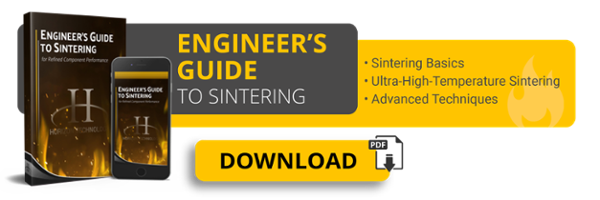At this point, we all know that powder metallurgy can make small, complex parts for a variety of industries, including:
- Electric motors
- HVAC
- Automotive
- Firearms
- Lawn and garden
But there are several decisions to be made when considering the most effective metal forming technology for the job. Engineers must look at performance needs and tolerances, as well as budget limitations and production quantities.
Sintering is a required PM process step to improve a part’s strength. A compacted PM part is heated in a furnace up to about (typically) 2100º F, after which it might move on to various secondary operations.
While most PM parts are sintered, not all materials are conducive for sintering. SMC materials lose their magnetic performance when sintered. But that is only one of the many variables when it comes to sintering:
Sintering Advantages and Disadvantages: The Variables
All powder metal parts need to be sintered unless they require the magnetic qualities of soft magnetic composite (SMC) materials. Sintering is a customizable process and will vary depending upon the materials, properties required, and the desired tolerance.
Sintering processes vary from part to part, including changes in:
- The amount of time at temperature
- The temperature itself
- Atmospheric conditions
Some of the keys to sintering are the creation of metallurgical bonds between materials, reduction of variability, and minimization of part waste. Advances in sintering furnace technology now offer the ability to control the furnace in real-time, which improves these fundamental elements of the sintering process.
New, advanced systems like these help manufacturers streamline their processes and collect better data about the end quality of your part.
Sintering Considerations: The Material
What is the material system you would use to create a new design PM application?
Let’s begin with a clear distinction of the needs of different part applications.
High strength structural applications often have requirements of high:
- Tensile strength
- Fatigue strength
- Particle hardness
These core requirements necessitate higher alloy and carbon contents and strength-inducing heat treatments. Unfortunately, these requirements also lead to significantly reduced DC magnetic performance.
Improving Performance With Sintered Soft Magnetics
However, not all parts have specific strength requirements. Thinking about parts that need good magnetic performance, these sintered soft magnetic parts often need:
- Very low carbon content
- High-purity materials
- Heat treatments to optimize magnetic properties
Certain alloying elements in iron such as phosphorus and silicon can improve magnetic performance and also give minor improvements in structural strength, but not to the level possible with higher-strength structural materials.
This type of material might be appropriate for applications like armature housing or fuel injection systems with magnetic solenoids.
Solenoids
Sometimes the right magnetic performance can be achieved with a variety of materials; in many instances an iron-phosphorus will satisfy the requirements of these applications. However, certain higher performance or faster responding solenoids will require the properties of an iron-silicon material that has been sintered at ultra-high temperatures to meet these demanding levels of magnetic performance.
One of the primary allures of powder metal is the ability for unique material formulations and shape-making capabilities. Powder mixtures can be tailored to meet specific needs, and paired with the proper sintering, can greatly improve your overall performance to make a better, longer-lasting part.
Standard Sintering vs. Sinter Hardening
With standard sintering, we focus on creating metallurgical bonds between materials. Sinter hardening takes that process a step further to provide heat-treated properties to a sintered part.
Sinter hardening is an accelerated cooling process that increases the metal’s hardness to improve resistance to deformation under stress. Sinter hardening takes advantage of the intrinsic heat put into the part during the sintering step and combines this with an accelerated cooling to then effectively heat treat the part to achieve high hardness and strength.
Conventionally, you’d have to form a part, sinter, and heat treat it. But with sinter hardening, we can eliminate a thermal cycle and rely on PM’s inherent net shaping capabilities to eliminate machining after sinter hardening.
Plus, the part-to-part variation is much lower when using sinter hardening as compared to traditional sinter-heat treat-quench processes.
A caveat of sinter-hardened parts: traditional machining operations can be difficult due to the hardness of the part.
High-Temp Sintering vs. Ultra-High-Temp Sintering (UHTS)
Traditionally, people think that high-temp sintering utilizes temperatures of 2100-2300ºF. Engineers have realized high-temp sintering offers an improvement in mechanical qualities over the ordinary sintering process, but often still falling short of other metal-forming technologies such as forging.
Technological improvements in powder metallurgy have led to the development of ultra-high-temperature sintering (UHTS). Just picture high-temp sintering, but after it’s had a lot of coffee.
Utilizing ultra-high-temp sintering, the compacted ferrous powder is sintered at temperatures approaching 2500° F, far above normal sintering temperatures. As the temperature rises, so does the cost of sintering, but this cost is often offset by the dramatic increase in part performance.
It also allows the PM process to use non-traditional alloying elements that can give unique combinations of strength, ductility, hardness, and heat treat response.
If the current part works with conventional sintering, you probably can't justify the cost of upgrading to UHTS. But potential DC magnetic applications and high-strength components could benefit from new material possibilities only achievable with UHTS.
Other Uses of Sintering for Powder Metallurgy
Sintering is also suited for unique parts that require low-density, high-porosity gas flows.
Using a protective mask analogy, this would be similar to breathing through an n95 mask vs. a conventional mask. The looser the weave, the easier it is to breathe and let particles through. The tighter the weave, the harder it is to breathe and for particles to move through.
With a filter, you want certain things trapped outside, so a high-porosity material is a must. Proper sintering can not only create a tighter, more compact shape -- but can be tailored to create the necessary open porosity to optimize the often conflicting properties of good flow and filtration.
Improving Part Tolerances and Efficiency with Sintering
When it comes to decoding the benefits of sintering, work with an expert powder metallurgy consultant that can recommend the best approach for cutting costs and fulfilling your needs. (Note that only Horizon’s furnace technology has the unique capability to both sinter-harden and sinter at ultra-high temps.)
To learn more about sintering, take a look at our new guide!



